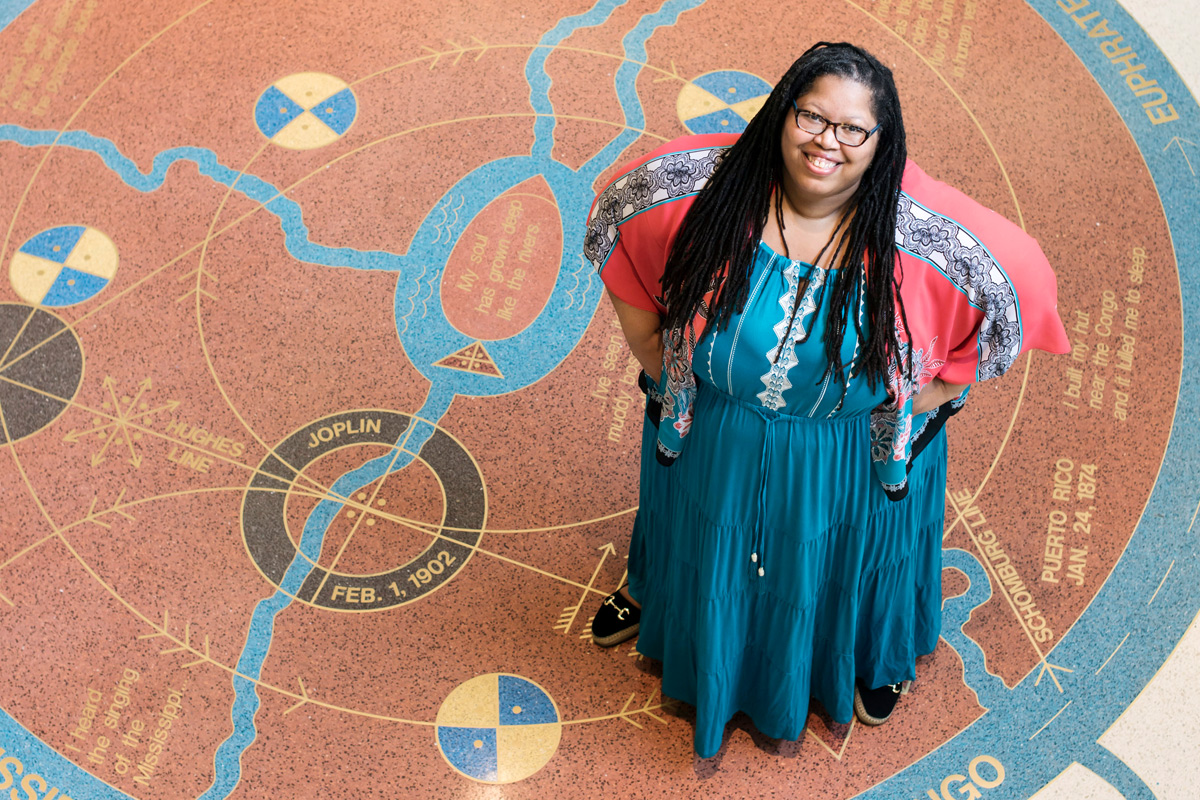How do you teach The Autobiography of Malcolm X, or the history of the civil rights movement, to students with varying degrees of literacy? How do you help children relate classical mythology or fairy tales to their own lives and circumstances? How do you move the needle on issues of social justice when people are bombarded by political messages and short on time and attention?
Deirdre Hollman’s answer is “the arts,” which she believes best encompass what the late TC philosopher Maxine Greene called “the five senses, wide open, experiencing the world through all of the humanities.” Witness Hollman’s own constantly morphing career as hip-hop video producer, filmmaker, poet, playwright, educator and comic book impresario.
“I always say I’ve lived many lives,” says Hollman, who is studying toward her Ed.M. in Social Studies & Education at TC, with an eye toward a doctorate.
Growing up in rural Pennsylvania, Hollman seemed destined to become a scientist. She recalls walking through the woods, fascinated by everything she could see, hear, and smell. In high school, she competed in local and state science fairs and won a scholarship to attend the Pennsylvania Governor’s School for the Sciences. Yet something inside her hungered for more. It wasn’t until she took an art history course during her freshman year at Princeton that she figured out what it was. She switched majors, from psychology, and never looked back.
“Studying art...also engages issues of culture, politics, philosophy, history and the future. As such, critical engagement with the arts provides limitless opportunities for educational experiences.”
After college, she found her way to New York City, where she became involved in the burgeoning independent film scene. Serving as assistant to up-and-coming film and video director Millicent B. Shelton, she wrote and produced videos for numerous influential acts during the years when hip-hop was entering mass popular consciousness, working alongside pivotal figures like Hurby “Luv Bug” Azor, Salt-N-Pepa, and MC Lyte. She also wrote monologues for friends to use at off-off-Broadway auditions, and eventually wrote and produced her own full-length plays. Then one day an actor friend teaching workshops with young students in the South Bronx asked her for help: he was having trouble encouraging them to create theatre out of fairy tales. Hollman suggested asking the students to situate the stories and myths in their own neighborhoods and cultures, and in the process, inspired herself: “When I centered myself, I knew that the space for me was arts in education.” Soon afterward she enrolled in an independent study master’s program at Bank Street College, focused on middle school education, museum education, and leadership.
“Studying art puts you in conversation with an artist whose work and being reflects a particular moment in time,” she says. “This aesthetic conversation also engages issues of culture, politics, philosophy, history and the future. As such, critical engagement with the arts provides limitless opportunities for educational experiences.”
Meanwhile, Hollman also began working at the New York Public Library’s Schomburg Center for Research in Black Culture, eventually becoming Director of Exhibitions and Education and the Junior Scholars Program. In teaching children across a wide spectrum of ages and abilities, one of her innovations was to use graphic novels and comic books to introduce students to literature and history. She subsequently co-founded the Annual Black Comic Book Festival, which has run for five years and features independent comic book artists, writers, and publishers. “These indy comic creators are really taking on issues of representation, history and social justice in imaginative ways that explode the speculative potential of the medium,” she says. “It’s not all just superheroes and save-the-world hyperbolic heroism; it’s about finer, more relatable stories of heroism and super humanity.”
“It’s through the lens of culture and art that we can really begin to understand each other and participate in this democracy together.”
One of Hollman’s own heroes is historian and former Schomburg director Khalil Gibran Muhammad. Her decision to focus her graduate work on social studies – and, more specifically, on the influence of the Black Studies and Black Arts movements on community and civic education – reflects his belief (expressed this past spring in his remarks at TC’s Convocation) that history is central to understanding America’s enduring legacy of racism. At TC, she has pursued that line of inquiry working with faculty member Bette Weneck and the Center for History and Education; with Yolanda Sealey-Ruiz, Associate Professor of English Education, through Sealey-Ruiz’s Racial Literacy Roundtables; and through ongoing collaboration with the Institute for Urban and Minority Education.
Hollman also deeply admires Maxine Greene: “She was everything: a philosopher, a poet, a teacher. Her writing even incorporated quotes from scientists as well as mothers and artists.” Yet Greene ultimately believed that “it’s through the lens of culture and art that we can really begin to understand each other and participate in this democracy together.”
